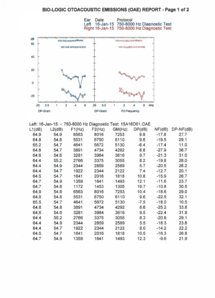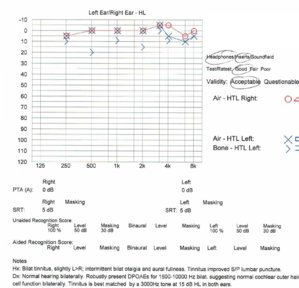Thought i would share how to find out if you have permanent tinnitus or not. The first test is the typical pure tone audiogram up to 8000 htz that almost every ENT will perform. If that has substantial hearing loss greater than 20 DB at one of the frequencies then that is likely to be a red flag.
So what about those of us with normal audiograms? Well the trick to this answer is that you can have a perfectly normal audiogram (with Normal hearing) however the cochlear damage that is resulting in your Tinnitus will appear very clearly on DPOAE tests. For those wondering what DPOAE means it stands for Distortion Product Otoacoustic Emissions. The test will will show near exact proximity to where your Tinnitus is coming from. DPOAE measures your hair cells which many scientists agree are part of the reason many if not most get T (from damaged hair cells).
If you have Tinnitus in 1 ear, and despite having a perfect near normal audiogram this is in particular of interest as the Rights vs. Left DPOAE results will show dips where the T is.
Hope this will be of help for those wondering why I have Tinnitus with PTA. My advice is it's very clear on DPOAE.
So what about those of us with normal audiograms? Well the trick to this answer is that you can have a perfectly normal audiogram (with Normal hearing) however the cochlear damage that is resulting in your Tinnitus will appear very clearly on DPOAE tests. For those wondering what DPOAE means it stands for Distortion Product Otoacoustic Emissions. The test will will show near exact proximity to where your Tinnitus is coming from. DPOAE measures your hair cells which many scientists agree are part of the reason many if not most get T (from damaged hair cells).
If you have Tinnitus in 1 ear, and despite having a perfect near normal audiogram this is in particular of interest as the Rights vs. Left DPOAE results will show dips where the T is.
Hope this will be of help for those wondering why I have Tinnitus with PTA. My advice is it's very clear on DPOAE.

 Member
Member

